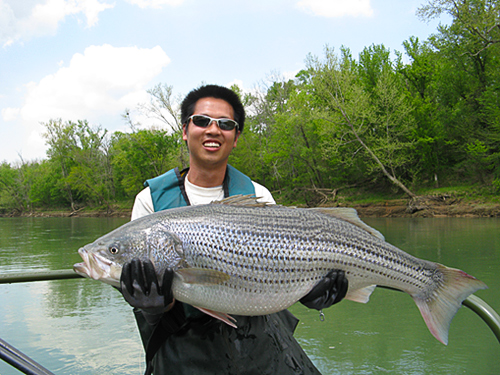BY Lee McClellan
FRANKFORT, Ky. – A jointed Thunderstick or Redfin lure slowly worked on the surface along a main lake bank on Lake Cumberland at 3 a.m. in early May could provoke a reaction from a striped bass that feels like it could rip your arm off your shoulder.

The savagery of a surface strike from a striped bass on a late spring night on Lake Cumberland is one of the outdoor experiences that sears into the brain, leaving a lifelong scar that itches every May.
The U.S. Army Corps of Engineers completed the repair work on Wolf Creek Dam in the past year and the lake level is inching its way back up, making the striped bass happy.
“It looks full to the eye,” said John Williams, southeastern fisheries district biologist for the Kentucky Department of Fish and Wildlife Resources. “I think it is going to be a really good year for striped bass fishing.”
Now, with lake levels approaching the historic summer pool, the stripers are gorging themselves.
“The striped bass are much healthier this year with better body condition and better growth,” Williams said. “Most anglers will notice a significant increase in size this year over last year. They grew better last year than the year before and I think the water quality is even better this year.”
Williams said population sampling for striped bass revealed a good population of fish from 25 to 32 inches long. “A couple of years ago, it was all 22 to 25 inchers,” he explained. “I don’t think they will be throwing many back this year.”
Currently, a 22-inch minimum size limit with a two fish daily creel limit is in effect on striped bass in Lake Cumberland.
Anglers right now are catching striped bass in the back of creeks by trolling live shad or alewives on down rods or planer boards from 5 to 25 feet deep. Stripers are also striking white doll flies cast to the banks in the creeks.
Live shad or alewives fished on the bottom on secondary points in the creeks also draw striped bass right now. Williams said they saw many stripers along the face of the dam recently during largemouth bass population sampling.
The night fishing bite is just starting.
“The baitfish haven’t really come up yet, so the night fishing for stripers hasn’t really taken off,” Williams explained. “They are catching some right now, but the cooler nights we’ve had will spread out the night bite out longer this year.”
The lower lake levels during the drawdown impacted the regionally renowned night fishing for striped bass on Lake Cumberland. The areas where striped bass at night used to pin spawning alewives and shad against the surface and rip through them changed during the drawdown.
“If the bait is not there, the stripers will not be there,” said Ryan Oster, fisheries program coordinator for Kentucky Fish and Wildlife. “I believe that many of those bluff banks that people used to fish became more of a sloping bank during the drawdown. They didn’t draw the spawning baitfish like before.”
Night striper anglers toss 5- to 7-inch medium-depth running crankbaits such as the Rapala Sliver along bluffs, steep banks and deep points earlier in the season. Stripers move progressively shallower as April moves into May, but always listen for the sound of striped bass hitting the surface.
If you hear something that makes you think someone dropped a large creek rock into the lake from a plane at 5,000 feet, then a striper just hit on top.
Switch to long, minnow-shaped lures such as the Redfin or the Jointed Thunderstick and fish them slow enough to barely create any action from the lure. Hold on tight to your rod.
Stripers often hook themselves from their fierce strike, but resist the temptation to set the hook immediately. Feel the weight of the fish before setting the hook. Large walleye, many of them well over 5 pounds, often hit these lures at night as well. If you set the hook too fast, you will lose the walleye. If you miss one and the lure has sharp scratch marks on it, you just lost a walleye.
“The night fishing usually lasts up until the end of May and sometime into June, but I think it will last longer this year,” Williams said. “Night striper anglers now have to contend with all of the flooded trees that make it difficult to cast a lure to the bank. The fish are there, but finding the right bank that you can effectively fish is key.”
Author Lee McClellan is a nationally award-winning associate editor for Kentucky Afield magazine, the official publication of the Kentucky Department of Fish and Wildlife Resources. He is a life-long hunter and angler, with a passion for smallmouth bass fishing.
-30-
The Kentucky Department of Fish and Wildlife Resources manages, regulates, enforces and promotes responsible use of all fish and wildlife species, their habitats, public wildlife areas and waterways for the benefit of those resources and for public enjoyment. Kentucky Fish and Wildlife is an agency of the Tourism, Arts and Heritage Cabinet. For more information on the department, visit our website at fw.ky.gov.


Be the first to comment